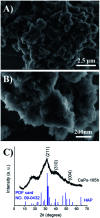Preparation of porous calcium phosphate microspheres with phosphate-containing molecules at room temperature for drug delivery and osteogenic differentiation
- PMID: 35539788
- PMCID: PMC9082617
- DOI: 10.1039/c8ra03943g
Preparation of porous calcium phosphate microspheres with phosphate-containing molecules at room temperature for drug delivery and osteogenic differentiation
Abstract
Calcium phosphate (CaP) has similar chemical properties to those of the inorganic component of human bone tissue, for potential application in drug delivery for the chemotherapy of osteosarcoma. In this work, CaP with a porous microsphere structure has been synthesized using fructose-1,6-bisphosphate (FBP) as the phosphorus source by a simple wet-chemical strategy at room temperature. The CaP porous microspheres, as an organic-inorganic hybrid nano-platform, exhibit good doxorubicin (Dox) loading capacity, and Dox-loading CaP, enhancing the in vitro chemotherapy of osteosarcoma cells. The CaP porous microspheres show high biocompatibility, and induce the osteogenic differentiation of MC3T3-E1. These results indicate that the CaP porous microspheres reported in this study are promising for application as an anti-osteosarcoma drug carrier and osteoinductive material for bone regeneration in the treatment of osteosarcoma.
This journal is © The Royal Society of Chemistry.
Conflict of interest statement
There are no conflicts to declare.
Figures














Similar articles
-
Calcium phosphate-phosphorylated adenosine hybrid microspheres for anti-osteosarcoma drug delivery and osteogenic differentiation.Biomaterials. 2017 Mar;121:1-14. doi: 10.1016/j.biomaterials.2016.12.031. Epub 2016 Dec 28. Biomaterials. 2017. PMID: 28063979
-
Strontium-Doped Amorphous Calcium Phosphate Porous Microspheres Synthesized through a Microwave-Hydrothermal Method Using Fructose 1,6-Bisphosphate as an Organic Phosphorus Source: Application in Drug Delivery and Enhanced Bone Regeneration.ACS Appl Mater Interfaces. 2017 Feb 1;9(4):3306-3317. doi: 10.1021/acsami.6b12325. Epub 2017 Jan 24. ACS Appl Mater Interfaces. 2017. PMID: 28068758
-
Fructose 1,6-bisphosphate trisodium salt as a new phosphorus source for the rapid microwave synthesis of porous calcium-phosphate microspheres and their application in drug delivery.Chem Asian J. 2013 Jan;8(1):88-94. doi: 10.1002/asia.201200901. Epub 2012 Nov 28. Chem Asian J. 2013. PMID: 23192854
-
The role of calcium phosphate surface structure in osteogenesis and the mechanisms involved.Acta Biomater. 2020 Apr 1;106:22-33. doi: 10.1016/j.actbio.2019.12.034. Epub 2020 Jan 9. Acta Biomater. 2020. PMID: 31926336 Review.
-
Bone tissue engineering via nanostructured calcium phosphate biomaterials and stem cells.Bone Res. 2014 Sep 30;2:14017. doi: 10.1038/boneres.2014.17. eCollection 2014. Bone Res. 2014. PMID: 26273526 Free PMC article. Review.
Cited by
-
Innovative Biomaterials for the Treatment of Bone Cancer.Int J Mol Sci. 2021 Jul 30;22(15):8214. doi: 10.3390/ijms22158214. Int J Mol Sci. 2021. PMID: 34360979 Free PMC article. Review.
-
Biomaterial-assisted local and systemic delivery of bioactive agents for bone repair.Acta Biomater. 2019 Jul 15;93:152-168. doi: 10.1016/j.actbio.2019.01.060. Epub 2019 Jan 31. Acta Biomater. 2019. PMID: 30711659 Free PMC article. Review.
-
Bone Diseases: Current Approach and Future Perspectives in Drug Delivery Systems for Bone Targeted Therapeutics.Nanomaterials (Basel). 2020 May 1;10(5):875. doi: 10.3390/nano10050875. Nanomaterials (Basel). 2020. PMID: 32370009 Free PMC article. Review.
-
Chitosan-Boric Acid Scaffolds for Doxorubicin Delivery in the Osteosarcoma Treatment.Polymers (Basel). 2022 Nov 6;14(21):4753. doi: 10.3390/polym14214753. Polymers (Basel). 2022. PMID: 36365746 Free PMC article.
References
LinkOut - more resources
Full Text Sources
Other Literature Sources
Miscellaneous

